BIOLUM is a VR experience directed by Abel Kohen that had its première at SXSW Online 2021: a work with narrative at its core that uses the potential of VR to talk about science fiction.
There are some worlds that are perfect for being told in VR. Alice in Wonderland, for example. Its strange creatures, its even stranger rules find the perfect medium in immersive technologies and in fact there is a long list of experiences and installations dedicated to it.
Another kind of world that finds in this technology a fantastic way to be represented is that of science fiction.
We recently encountered an example of this marriage in The Metamovie Presents: Alien Rescue, a live VR cinematic experience presented at Venice77 and directed by Jason Moore (here‘s our interview).
At SXSW Online 2021, the lineup of the Virtual Cinema Competition offered another and different example of how VR can be applied to tell the peculiarities that characterize science fiction stories and to convey their eerie, sometimes nightmarish atmosphere.
BIOLUM, directed by Abel Kohen and produced by the French IKO and by the German companies REYNARD FILMS and PREFRONTAL CORTEX, is a cinematic VR experience that “thrusts the user into the role of Rachael, an experienced diver exploring the abyss, guided by expedition leader Eva, a renowned marine scientist and mentor”. A shocking truth awaits Rachael in those deep waters, where only luminescent creatures live – and if you’re someone who scares easily, let me tell you, facing those places with a headset on might be slightly terrifying.

I was impressed, when I experienced BIOLUM, by how it conveyed two of the key characteristics of these kinds of stories: the wonder at a world so different from what we’re used to – and the intense disquiet that, for exactly the same reason, this world inspires in us. It’s a piece where the atmosphere has to be breathed in, a piece that asks the user to leave behind the desire to see what works and what doesn’t or to experiment with the story, and simply go with the flow (almost literally) of the narrative.
Indeed, the storytelling is probably the thing that impressed me the most. Sure, you don’t have complex interactions to participate in, and it’s a classic cinematic story with a direction to follow from A to Z, but it’s in the way it convinces you to follow this pre-written direction that BIOLUM’s strength lies. The voice of Eva (played by Charlotte Rampling), your mentor and guide in this environment, gives you direct hints on what you need to do. But even more than that, the voice of the character you are playing, Rachael (voiced by Dominique Tipper), speaks for you and thus lets you know “your” state of mind, your thoughts about the situation and makes you feel the need to just accept this narration.
For some people, this might turn your experience into one of active witnessing of events that don’t directly affect you. To me, it was something different: an effective way to express through a visual medium what happens in first-person literary narration, where there is always an implicit request to the audience to accept the pact, intrinsic to any kind of narrative, between “reader” (or user, in this case) and author.
To simplify: in this narrative pact the reader is asked to accept the truth of what the author says and of the characters. If one accepts it, the experience of reading can thus become two things: something that drags you out of your world to visit a new one, and a performance where the reader “puts himself in the character’s shoes and recreates them, gives them substance and life […] The reader gives up something of themselves in order to acquire the thoughts and psychological states of the characters” (Gerrig, 1993; Levorato, 2000).
This is exactly what happens in BIOLUM and what, for me, made it natural to follow a path already laid out for me rather than trying to open up different narrative branches – which is something I usually live for.
We talked with director Abel Kohen about the origins of BIOLUM, the challenges and the excitement of creating it and here’s what he told us.
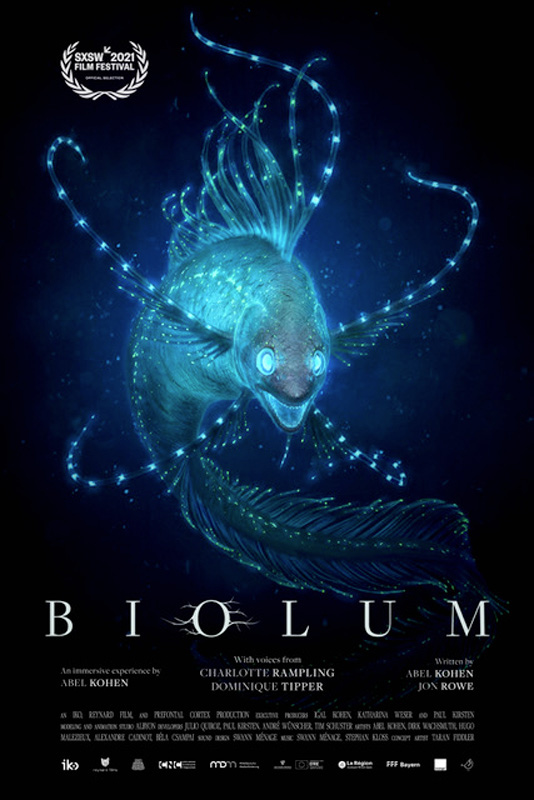
At the origins of BIOLUM
AGNESE – When did you start working on this piece?
ABEL KOHEN – Back in 2015, when I discovered the work of a marine biologist called Edith A. Widder, I fell in love with bioluminescence. I started watching documentaries about it. I was very fascinated by this strange abyss where creatures of different species speak the same language, the language of light. It’s all so sci-fi, exciting… and it’s beautiful!
I’m a visual artist, so I immediately started creating small animations set in that world, underwater images of bioluminescent deep sea creatures. These animations garnered some interest on Reddit and were a bit of an internet success, so from there I started building an entire project, along with my brother who is a producer at IKO.
Initially the idea was to create a documentary web series about fictional creatures. Early feedback from funding committees recommended adding a human character to cling to in order to create a stronger story. That’s when we decided to scrap the documentary idea and started working on a web series, a vlog about an expedition at sea where scientists discover a new parasite.
We built the entire BIOLUM world for that project and a mini-pilot that would work as a prequel, and we conceptualized a VR episode set in the same story world, but as a standalone. And it was the latter idea that sparked the most interest and got us fundings first for a conceptual prototype and then eventually for the full production. It became the core of our efforts over the last two years and we worked on it very hard on it until practically last week! [laughs]
A. – At the origins of BIOLUM there is a very transmedia approach, then!
A. K. – Me, my co-writer Jon Rowe who is also a very talented TV Story Producer, and my brother, Igal Kohen, producer of the piece, discussed various incarnations of the same story world: the web series, but also a longer format tv-series, even a feature film existing in the same universe. Obviously the original idea of creating a vlog was very much related to my own media consumption at the time, but yes, it was a very transmedia approach, which is something my brother is an expert on.
The world of BIOLUM allows for any kind of storytelling within and any format. Fictionalizing it was an interesting thing for us to explore at that point. Unfortunately, we couldn’t make it happen, but everything we created and wrote up that point was the backdrop on which we built the VR experience.
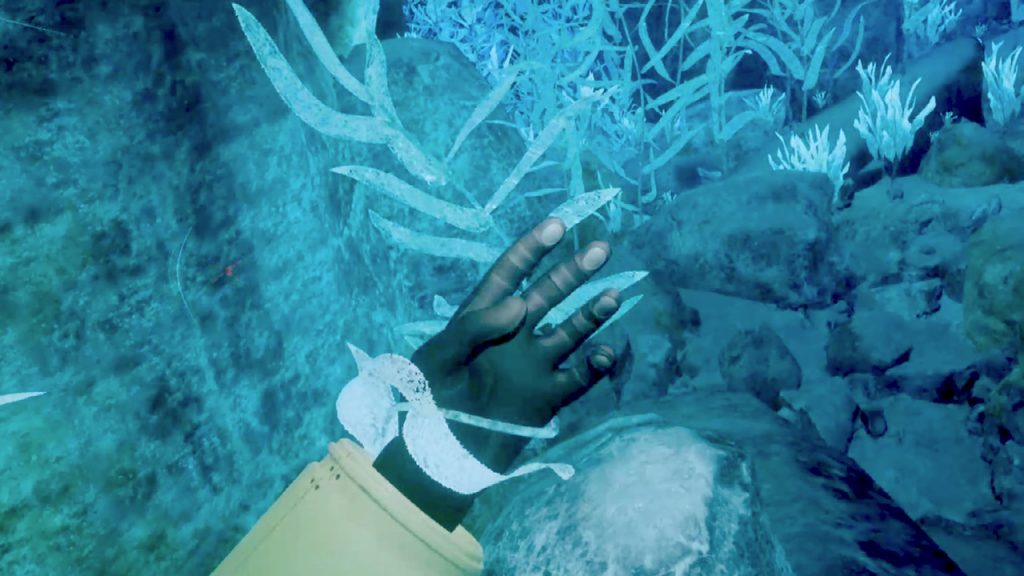
On the role of VR and interactive features in BIOLUM
A. – What do you think VR added to your idea of BIOLUM?
A. K. – It’s almost a cliché to say it at this point, but what VR really added to our piece was immersion, the concept of presence. If you put people in a 360 or 6dof environment, the suspension of disbelief happens in a much stronger, effective way than on a 2D screen. It makes stories more impactful.
I also feel that interaction is key, something very important in VR. Our experience is only lightly interactive, however, because we decided to focus more on the narrative. It’s a choice I’m perfectly happy with, but still a choice that we made early on. Storytelling in VR is based on a completely different grammar than filmmaking; we’re still discovering it and learning the right grammar, figuring out the tools and what works best for one experience and doesn’t work for a different one.
A. – You do have some interactive moments in the experience, though. And I wonder, how much agency does the user really have? For example, if I don’t try the torchlight when Eva asks me to, what happens to the story? Does my character say something different?
A. K. – In this specific case, the experience waits a few seconds and then, if the player has not tried the flashlight, continues with the dialogue, skipping that specific line.
We have a few different moments like this, where, if some things that should happen don’t, the story is still told in a reasonable time frame. Then we have a handful of moments where, if you don’t do what you’re expected to do, the story cannot move forward. We tried to minimize those moments, make them very easy to understand and unobtrusive and I think that we struck a balance between the use of interactivity and the creation of an experience that is willingly very narrative.
A. – Was BIOLUM always this way, in the plans, or was the interactivity supposed to be different at the beginning?
A. K. – We discussed the idea and the contents of BIOLUM over a very long development period, and when we wrote the first of many versions of the script, we started from a very ambitious place. At first, everything seems possible. You want as much interactivity as possible, to create a world where everything can be touched or grabbed.
But then you discuss it with the developers, you talk to your team and the producers who have more experience on VR and VR content, and you realize you have to narrow it down a little bit. I’m not a game developer nor a game designer, but I could see how much work a fully interactive piece required, how many things could go wrong. We realized that non-functioning interactions could hurt an experience that is intended to be very, very narrative much more than functioning interactions could enhance it.
So, we simplified things a lot and reduced the interactivity with time. What’s left is what the narrative really needs, what allows us to tell the story clearly while keeping the player engaged.
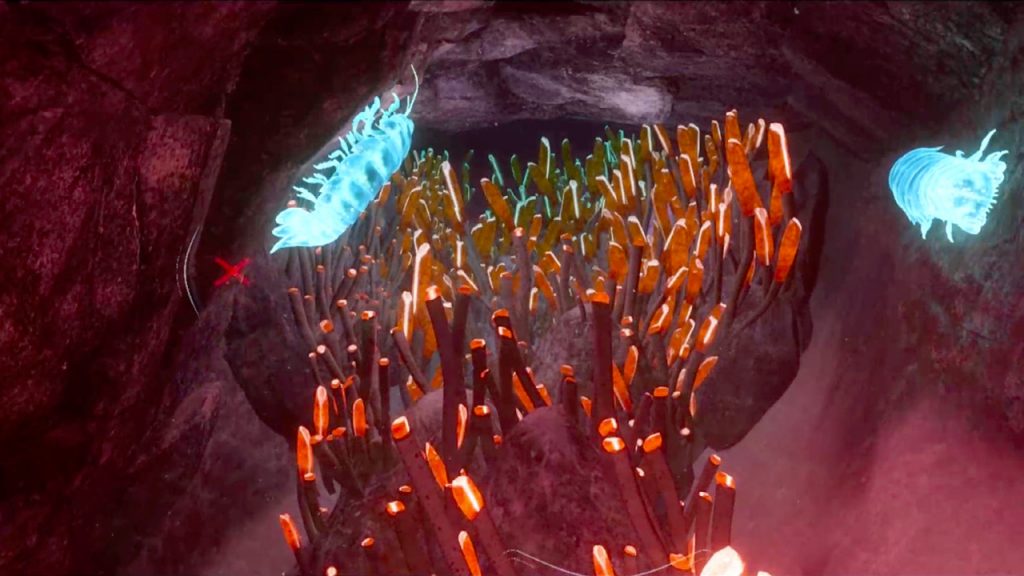
A. – Like with the torchlights…
A. K. – You can use the torchlights throughout almost the entire experience. I know this isn’t the only experience where there is this type of object, but I still feel that torchlights in VR have a magical touch. They give the user a way to visually transform the world they’re in and, also, there are times when you can interact with the fish using the torchlights: they try to avoid the light and all this gives a bit of playfulness to the work.
A. – What about the rail system that appears on the screen and that you can follow?
A.K. – We have a system of red lines that basically guide you through the experience. The user can go around the rail a little bit, but they have to stay on the path for the story to move forward. They don’t have the option to wander off and go see a distant rock.
We’ve also added a vocabulary borrowed from video game dynamics, with arrows and icons giving you hints on what to do – stop, there’s something to see, go in that direction and so on – to make the experience easier for the player.
Prioritizing storytelling: elements of BIOLUM that keep users on the “right” narrative path
A. – Your narrative works because you put the right hints in the story to convince the user to follow the path you’ve designed for them.
A. K. – The very first impulse for us was to create branching storylines of things that could potentially happen… but that required a bigger budget, a bigger team and longer production periods. So we went a different route. We decided to integrate some hints – like the icons I mentioned – within the narrative. They are integral to the story, but at the same time they’re tools we use to keep the user from walking away to look at things we haven’t worked on yet.
Mostly, we wanted to make the timing of the staging and the direction of everything to work as seamlessly as possible, so that the player could be taken from one scene to the next and to the end in a way that didn’t feel artificial. And I’m glad that it worked for you! I’m hoping it works for everyone! [laughs]
We would like that once people wear the headset, they can let the story come through – most of it is carried along by dialogue – and at the same time take the time to look around and interact when it’s required of them, and just enjoy the world we’ve crafted. We’ve done some testing and some players have decided to just stand in one place for a few minutes so to take in the world and everything we’ve put in it to try and give it some life.

A. – You just mentioned dialogues, and they are of the utmost importance in BIOLUM. From this point of view, it was important to have two very good actresses playing them. How was the voice recording experience like?
A. K. – We were incredibly lucky to have Charlotte Rampling and Dominique Tipper voice Eva and Rachael. It was incredible! There was a first recording session with Charlotte Rampling in Paris for Eva’s voice, which took place in a Covid-safe recording studio, and it was amazing. She’s a wonderful professional, incredibly talented, and her delivery is absolutely believable. It was a very powerful and exciting experience for me. I had her on the phone a few weeks before we started recording – she had read between the lines of our script and really understood what we were doing with it and the story. That, and then hearing her play the character and create this very strong performance was very touching.
With Dominique Tipper it was similar but different at the same time… She was recording from Toronto in a remote session. Her style is much more dynamic, she’s an incredible action actress and she had a very contrasting performance to Charlotte Rampling. It’s a shame we couldn’t get them to play off each other, because of Covid and all. But still, what we got out of it was exactly how we envisioned the characters.
We had been using machine-generated voices for months and months. Suddenly we hear dialogues not only from human voices, but from the voices of incredibly talented actresses…. well, it was a powerful moment for both me and Jon.
A. – Is there another great moment from your work at BIOLUM that you want to mention?
A. K. – When we saw that the lighting worked! Lighting for VR is a big technical challenge, a very complicated and difficult thing to manage. But seeing all the pieces fall together and the visual world suddenly gain coherence from one build to the next, and make our universe believable… well, that added power to the suspension of disbelief, it added immersion and, honestly, it was certainly one of the best moments.
A. – What about the challenges?
A.K. – We’ve had so many challenges… The organization itself has been quite difficult. BIOLUM is a European co-production, which is great and allowed the project to happen, but at the same time it brought a lot of complexity to our work and schedule.
When I started the project Jon and I were living in London, while the producing company IKO was in France. Later I moved to Paris, but the other two production companies, Prefrontal Cortex and Reinard Films, were in Germany. The team had to speak three languages depending on who was meeting whom, and to solve something that would normally take a five minute conversation we had to schedule meetings in advance to find matching availabilities.
Another challenge was the VR medium itself. VR is a fairly new medium. A lot of the technical and creative work is basically brand-new for every project, because every project has its own set of requirements, its own ambitions and there are a lot of solutions that don’t exist yet, but need to be figured out.
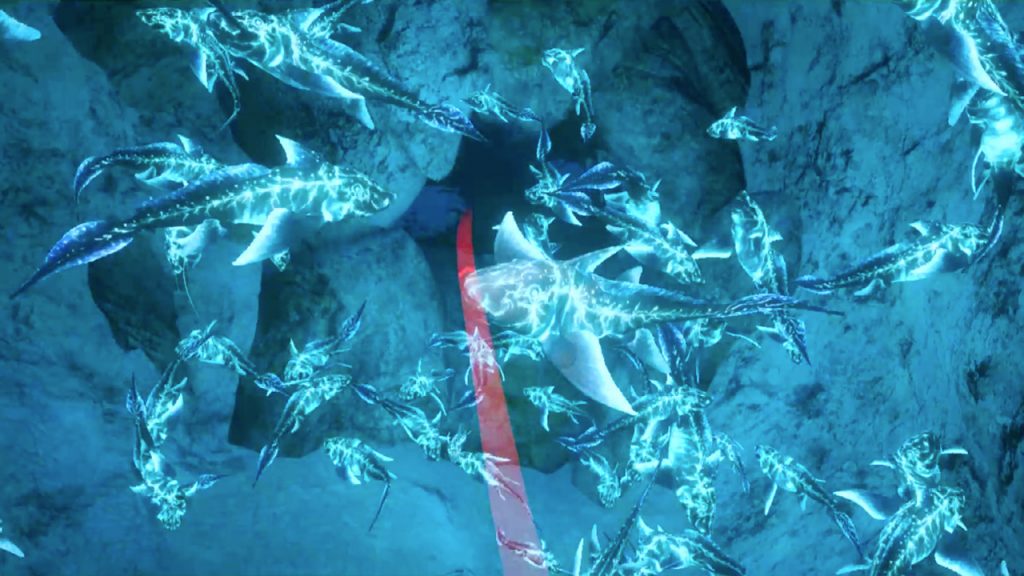
Today, a certain level of quality is expected of media experiences. They need to have a certain standard. Bringing VR to that standard was much more complicated than I expected. When I started this project I had almost no experience with real-time production and graphics. I came in with the expectation that it would work like a video game… and yes, it is similar to a video game but with extra difficulty. Still, I’m happy with the challenge, it was an interesting one.
I’m glad that we worked with developers who have more experience in this than I do and that we were able to tackle this kind of work together. BIOLUM is certainly an ambitious experience, and the budding technology sure didn’t make things easier. We’re still in the beginning but things will get better and easier with time.
A. – Something I have not asked you before, but that is quite relevant: where there specific artistic and narrative inspirations for BIOLUM?
A. K. – Absolutely. So many! On the one hand, the first spark came from nature: almost all the species we show on screen are made up of real species that have been exaggerated.
In terms of non-natural influences, there’s the Alien films series which called to me. The film Abyss, which was a big moment of my upbringing. Back in the writing stages we also talked a lot about Philip K. Dick, too. The big monster you see at the end of the experience? Its name doesn’t figure in the experience, but the working name, Glimmung, was borrowed from two Philip K. Dick’s novels: one is a children’s story called “Nick and the Glimmung” and the other one is “Galactic Pot-Healer”: both have the Glimmung as a character and it really stuck with me.
When we were discussing the work with Jon, we did it along the lines of “This is the Glimmung, this is how he works, this is why he exists, this is his place in the bioluminescent world at the bottom of the sea…”. We come after decades, even centuries, of literary and artistic progress and our work builds on that.
Another influential inspiration came from a videogame called Soma. It’s a sci-fi horror, set in a human scientific station in the deep sea. They have incredible storytelling, incredibly interesting and scary world-building and they also have the infection going on. We had a clear idea laid out about BIOLUM when we discovered Soma and we immediately noticed this narrative overlap between it and what we were working on. And Soma is such a masterpiece that discovering the elements we had in common was exciting!
On the future of BIOLUM
A. – What plans do you have now for this work?
A. K. – BIOLUM still has a few bits and bobs that we want to fix and elements that we want to add to the experience. Hopefully we will find a little bit more funding so we can get it from the current state into a marketable state. After that, we’re planning to have it on VR marketplaces like Steam and the Oculus Store and I’d also like to port it to Quest, so it can reach a wider audience!
BIOLUM is a work directed by Abel Kohen and produced by IKO, Reynard Films and Prefrontal Cortex, with the support of CNC, Région Auvergne-Rhône-Alpes, Bourse ORangeXR-SACD, MDM and IB.

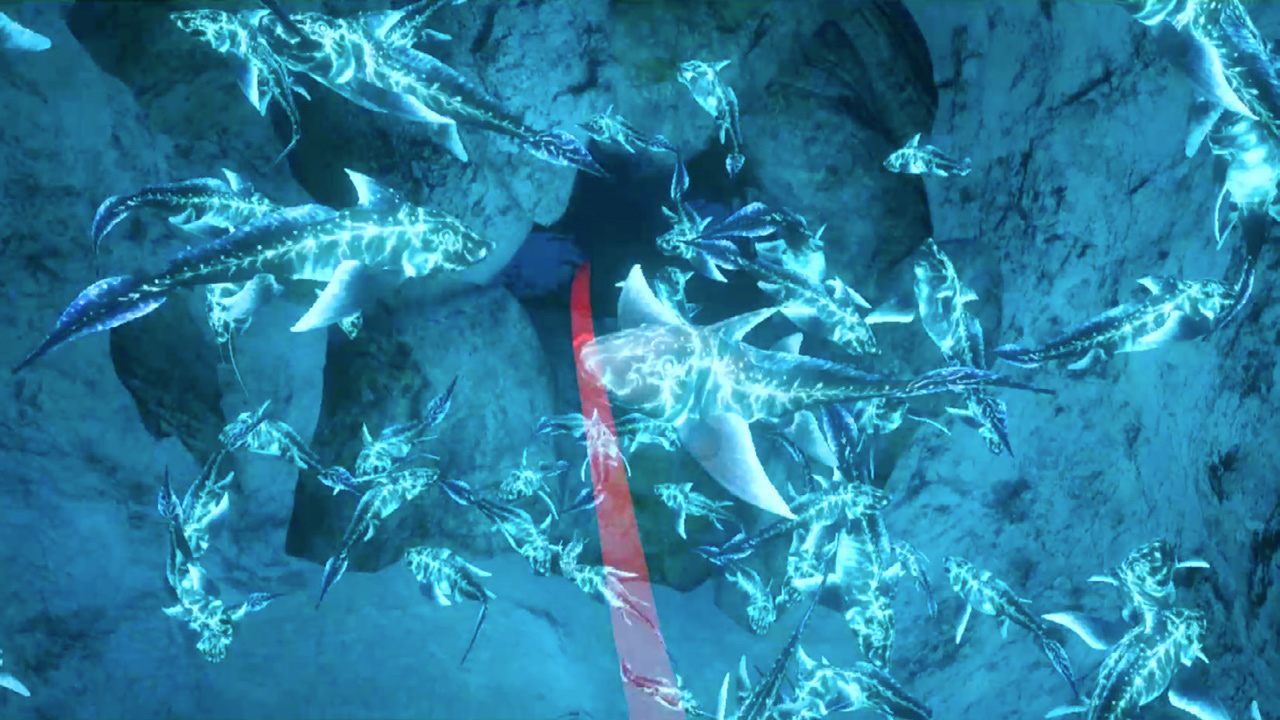

Leave a Reply
You must be logged in to post a comment.